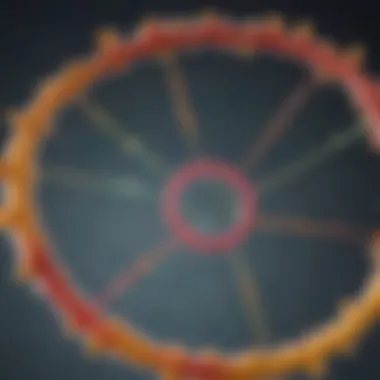Understanding the HindIII Cut Site in Genetic Engineering


Intro
In the realm of molecular biology, the ability to modify DNA has revolutionized research and therapeutic strategies. The HindIII restriction enzyme stands as a pivotal tool in the genetic engineering toolkit. Understanding the HindIII cut site is essential for anyone involved in genetic manipulation, from students to seasoned researchers. This section delves into the significance of the HindIII cut site and sets the stage for a deeper exploration of its biochemical and practical implications.
Research Overview
The investigation of the HindIII enzyme reveals crucial insights that advance genetic engineering.
Key Findings
- Enzyme Specificity: HindIII specifically recognizes the sequence AAGCTT and cleaves it between the A and the second A nucleotide.
- Applications: Its utility spans from cloning and sequencing to creating recombinant DNA molecules, which play a vital role in biotechnology.
- Characterization of Activity: The enzyme exhibits optimal activity at a specific pH and temperature, which must be accounted for in experimental designs.
Study Methodology
The analysis of HindIII has relied on various techniques, including:
- Enzymatic assays to determine activity under changing conditions.
- Gel electrophoresis to visualize DNA fragments post-cleavage.
- Comparative studies with other restriction enzymes to establish relative efficiency and specificity.
Background and Context
Understanding the historical context of the HindIII cut site provides clarity on its development and use.
Historical Background
The discovery of HindIII traces back to the early days of molecular cloning, where the need for precise DNA manipulation arose. This restriction enzyme was one of several identified in the late 1970s, paving the way for modern genetic engineering approaches.
Current Trends in the Field
Currently, the landscape of genetic engineering is rapidly evolving. Advances in gene editing technologies, such as CRISPR, complement traditional methods that utilize restriction enzymes like HindIII. The integration of these technologies is fostering innovative applications in medicine, agriculture, and synthetic biology, enhancing their relevance.
"The HindIII cut site exemplifies the intersection of classical and cutting-edge molecular techniques, illustrating the evolution of genetic engineering."
As we continue, this article will examine the biochemical properties of HindIII and its broader implications in genetic research. Understanding these concepts is crucial for leveraging the enzyme's capabilities in various applications.
Prolusion to Restriction Enzymes
Restriction enzymes, also known as restriction endonucleases, are essential tools in molecular biology. They play a pivotal role in genetic engineering by allowing researchers to cut DNA at specific sequences. This cutting ability facilitates numerous applications, including cloning, gene insertion, and molecular mapping. Understanding the principles of these enzymes is fundamental for anyone involved in genetics or genomics. It provides insight not only into the enzyme's mechanisms but also into broader genetic manipulation techniques.
The importance of restriction enzymes lies in their specificity. Each enzyme recognizes a particular sequence of nucleotides and makes precise cuts. This specificity ensures that DNA can be modified in a controlled manner, preventing unintentional changes to non-target regions. Furthermore, by understanding how restriction enzymes function, researchers can develop more effective strategies for gene editing and other molecular biology applications.
As we delve into the history and definition of restriction enzymes, we will uncover their significance in advancing the field of genetic engineering. The development of these enzymes marks a turning point in biological research and biotechnology, enabling innovations that continue to shape our understanding of genetics.
Definition and Function
Restriction enzymes are proteins that recognize and cleave specific sequences within DNA molecules. Typically, they cut the DNA strand at specific points, creating sticky or blunt ends. This cleavage allows for the dissolution of DNA fragments that can then be manipulated for various experimental purposes. In practical terms, these enzymes function as biological scissors, directing their activity based on the recognition of short, specific sequences known as recognition sites.
The function of restriction enzymes is crucial for several key processes, including:
- Cloning: They enable the insertion of desired DNA segments into plasmids or vectors, creating recombinant DNA molecules.
- Gene Analysis: By cutting DNA at specific sites, they allow for the examination of gene structures and genetic variations.
- Restriction Fragment Length Polymorphism (RFLP): They facilitate genetic fingerprinting and disease-related genetic research by analyzing variations in DNA sequences.
Understanding these functions helps clarify why restriction enzymes are indispensable in genetic research and applications.
History of Restriction Enzymes
The discovery of restriction enzymes dates back to the 1970s. The work of scientists such as Hamilton Smith and Dan Nathans depicted groundbreaking advancements in molecular biology. They identified the first restriction enzyme, HindII, derived from the bacterium Haemophilus influenzae. This pioneering discovery opened new avenues in genetics, leading to the development of recombinant DNA technology, which is foundational for modern genetic engineering.


In the subsequent years, numerous other restriction enzymes were discovered with varying recognition sites, expanding the toolkit available to molecular biologists. This era marked the transition from basic genetic understanding to the practical application of DNA manipulation in research and therapeutic contexts.
As the field continues to evolve, the history of restriction enzymes serves not only as a testament to scientific innovation but also as a foundation for future discoveries. The continuous improvement in enzyme specificity and efficiency further enhances the potential for genetic engineering.
Hindiii Overview
The HindIII restriction enzyme holds a critical position in the field of molecular biology and genetic engineering. Understanding this enzyme enhances researchers' abilities to manipulate DNA, contributing significantly to advancements in genetic research. Knowledge about HindIII's function and characteristics allows for more informed choices in experimental design.
Discovery of Hindiii
Discovered in 1970 by the researchers at the University of California, San Francisco, the HindIII enzyme was isolated from the bacterium Haemophilus influenzae. It stood out due to its capacity to recognize and cut specific sequences in DNA. This discovery laid the groundwork for various molecular biology techniques that would follow. Initially, the utility of HindIII was limited to academic settings. Over decades, however, its role expanded dramatically within the scientific community.
Molecular Structure
HindIII is a Type II restriction endonuclease. Type II enzymes cleave DNA at defined sequences without requiring additional sequences for recognition. This enzyme specifically targets the palindromic sequence 'AAGCTT'. The cutting yields flush ends, which are vital for cloning applications as they facilitate the ligation of DNA fragments.
The structure of HindIII is composed of multiple domains that contribute to its catalytic activity and specificity. The enzyme has a central role in the cleavage process, where its active site interacts with DNA. The precise recognition and cutting mechanisms ensure that the enzyme operates effectively under physiological conditions. Researchers focus on these structural details to improve and design more effective biotechnological tools.
Mechanism of Action
The mechanism behind HindIII's action involves several steps. Firstly, the enzyme binds to its DNA target based on sequence specificity. Once bound, it catalyzes the cleavage of the phosphodiester bonds within the DNA backbone. This results in the separation of the DNA strands. Hence, the reaction leads to the formation of two distinct segments of DNA with cohesive ends.
The efficiency of this mechanism is determined by the concentration of the substrate, pH, and temperature. Under optimal conditions, HindIII performs with high efficacy, making it an essential tool in various genetic manipulation efforts.
By understanding this mechanism, researchers can optimize their protocols for successful applications in cloning and gene editing.
Identifying the Hindiii Cut Site
Identifying the Hindiii cut site is essential for understanding its role in genetic engineering. The specificity of this restriction enzyme directly influences the precision of genetic modifications. Knowledge of the cut site allows researchers to design experiments with foresight, minimizing unintended effects when manipulating DNA. This section outlines the key aspects that define the efficacy and utility of the Hindiii enzyme.
Sequence Specificity
Hindiii recognizes and cleaves a specific DNA sequence: 5'-AAGCTT-3'. This sequence specificity is crucial in applications like cloning, where the targeted insertion of genes is paramount. The ability of Hindiii to cut at well-defined locations simplifies the process of constructing recombinant DNA. By employing Hindiii, researchers can predict the behavior of DNA fragments after cleavage, allowing for more controlled experimentation. This precision aids in assembling multiple DNA fragments correctly during cloning, ensuring the integrity of genetic constructs.
"Understanding the sequence specificity of restriction enzymes like Hindiii is fundamental to successful genetic manipulation."
Visualizing the Cut Site
Visualizing the Hindiii cut site is vital for assessing the effectiveness of experiments in molecular biology. Techniques like agarose gel electrophoresis are frequently used to evaluate DNA fragments resulting from Hindiii digestion. After running gel electrophoresis, stained DNA bands can be compared to a DNA ladder. This comparison allows researchers to confirm whether the expected sizes of fragments were produced.
The outcomes can be documented and analyzed to ensure that the cleavage has occurred precisely at the anticipated sites. Compression of the results into clear visual formats, such as graphs or images, can aid in the interpretation of multiple experimental variants.
The integration of software tools also enhances the capability to visualize these processes, offering dynamic ways to represent data. This visualization helps inform future experiments and decisions, ultimately improving the overall efficiency and precision of genetic engineering projects.
Applications in Genetic Engineering
The HindIII cut site is a critical element in the landscape of genetic engineering. Its specific sequence recognition allows for precise manipulation of DNA, making it invaluable for various applications within the field. Understanding how HindIII operates empowers researchers to leverage this enzyme effectively in tasks like gene cloning, PCR amplification, and modern gene editing techniques. Each of these applications not only showcases the enzyme's versatility but also its importance in experimental design and biotechnology advancements.
Cloning and Gene Insertion
Cloning is the process of creating identical copies of a molecule. The HindIII enzyme is utilized for cutting DNA at specific locations, enabling the insertion of foreign genes into plasmids or other vectors. The specificity of HindIII to its recognition sequence ensures that the process is efficient and accurate, reducing the likelihood of errors during cloning. This characteristic is particularly beneficial when introducing therapeutic genes or genes of interest into host cells.
To perform cloning with HindIII:
- Start with vector preparation: Isolate the vector DNA, typically a plasmid, and cut it with HindIII to create compatible ends.
- Insert the gene of interest: The target gene, which can also be pre-cut with HindIII, is then ligated into the opened plasmid, creating a recombinant DNA molecule.
- Transformation: The recombinant vector is introduced into host bacteria, where it replicates, allowing for amplification of the inserted gene.


This cloning approach is widely applied in research for gene expression studies, production of proteins, and the development of genetically modified organisms.
PCR Amplification
Polymerase Chain Reaction (PCR) is a technique used to amplify specific DNA segments. While HindIII is not directly involved in the amplification process itself, its role is significant in preparing templates for PCR. Before amplifying a target sequence, researchers often digest DNA with restriction enzymes like HindIII to confirm the presence of specific sequences or to create fragments suitable for downstream applications.
In PCR, the following steps are pertinent:
- Template Preparation: Before PCR, using HindIII to cut DNA helps verify the presence of a target region.
- Amplification: Once prepared, standard PCR methods are employed to amplify the regions of interest, facilitating further molecular analyses.
By integrating HindIII's cutting capabilities prior to PCR, researchers enhance the accuracy and reliability of their results.
Gene Editing and CRISPR
Gene editing has transformed molecular biology, enabling precise alterations to the genome. The emergence of CRISPR technology, specifically the CRISPR-Cas9 system, capitalizes on the principles established by restriction enzymes like HindIII. Although CRISPR does not use HindIII, understanding the principles of restriction enzyme action is fundamental when designing gene editing experiments.
CRISPR operates with the following factors:
- Guide RNA: Directs the Cas9 enzyme to a specific DNA location.
- Cas9 Enzyme: Introduces double-strand breaks in the target DNA.
- Homology Directed Repair (HDR): After cut by CRISPR, scientists can introduce genetic modifications by using templates or donor DNA, similar to cloning but with high precision.
In summary, while the roles of HindIII and CRISPR may differ, the fundamental principles behind genetic manipulation link them together in the broader context of genetic engineering.
"Restriction enzymes like HindIII have set the groundwork for advanced techniques such as CRISPR, reshaping our approach to genetics."
Through its applications in gene cloning, PCR amplification, and gene editing, the HindIII cut site remains an essential tool in the genetic engineering toolbox, offering precise, reliable, and innovative solutions to complex biological problems.
Hindiii in Research
The HindIII enzyme has been pivotal in various research domains, significantly influencing studies in molecular biology and genetic engineering. Its ability to cleave DNA at specific sequences allows scientists to manipulate genetic material with precision. This capability opens avenues for innovative research, enhancing our understanding of genetic functions and facilitating the development of novel applications.
Case Studies
Numerous case studies illustrate the utility of HindIII in research. One prominent example is its role in cloning experiments. Researchers have used HindIII to create recombinant DNA molecules. In a study focused on the cloning of a Green Fluorescent Protein (GFP) gene, HindIII was essential to ensure that the gene was inserted correctly into a plasmid, which allowed for effective expression in host cells. Such case studies highlight how HindIII aids in producing biologically active proteins that can be used for various applications, including drug development and bioimaging.
Another significant case study involves the gene therapy sector. Scientists have utilized HindIII to facilitate the insertion of therapeutic genes into patient cells, aiming to correct genetic disorders. For instance, a study investigated the use of gene delivery systems in which HindIII was utilized to cut vectors at precise locations, allowing the incorporation of corrective genes. This case demonstrates not only the practical application of HindIII but also its potential to contribute to medical advancements.
Comparative Enzyme Studies
The assessment of HindIII against other restriction enzymes offers insights into its unique characteristics and advantages. Comparative enzyme studies typically evaluate factors like cleavage efficiency, specificity, and reaction conditions. One such study compared the performance of HindIII with EcoRI, another widely used restriction enzyme.
Researchers found that HindIII has a higher degree of specificity for its recognition sequence compared to EcoRI. This specificity minimizes the likelihood of unwanted cuts, which is crucial in applications like gene editing. Additionally, HindIII operates optimally under slightly different pH conditions, allowing researchers to choose the best enzyme based on their experimental setup.
The comparative studies contribute to a broader understanding of how various restriction enzymes can be strategically applied in different contexts. Such knowledge empowers researchers to select the most appropriate enzyme for their specific needs, thereby improving the outcomes of their genetic engineering projects.
Ultimately, HindIII is not just a tool for genetic manipulation; it is a catalyst for discovery in biological research. By analyzing its effectiveness in various scenarios, researchers can harness its potential to advance scientific knowledge and address challenges in genetics.
Limitations and Challenges
The study of the HindIII cut site encompasses numerous implications that extend into genetic engineering and molecular biology. Despite its notable applications, several limitations and challenges must be considered. Understanding these aspects will help researchers and students navigate potential hurdles when designing experiments or interpreting results.
Efficacy in Different Conditions
The efficacy of the HindIII restriction enzyme can vary significantly under different experimental conditions. This variability is influenced by factors including temperature, pH, and the ionic strength of the reaction buffer. For instance, HindIII exhibits optimal activity at a temperature range of 37-50 °C, but deviations from this range could lead to decreased cutting efficiency. In a laboratory setting, it is vital to maintain the appropriate conditions for the best results.
Moreover, the presence of certain inhibitors can affect enzyme activity. For example, phenolic compounds or high concentrations of sodium can interfere with the enzyme's function. Researchers must take care to prepare their samples in a way that minimizes such inhibitors.


Potential for Off-Target Cuts
One significant concern with the use of HindIII is the potential for off-target cuts. While this enzyme is designed to recognize and cleave specific DNA sequences, it can sometimes also cut at similar, non-target sites. These off-target effects can lead to unintended genomic modifications, which may cause problems in downstream applications like gene editing or cloning.
To mitigate these risks, researchers often employ careful sequence selection and validation strategies. Aligning the target sequence to be certain that it is unique within the context of the entire genome is one approach. Additionally, newer technologies that utilize more precise enzymes can also be considered.
In summary, understanding the limitations regarding efficacy and off-target cuts is crucial for advancing research and applications utilizing the HindIII cut site. Navigating these challenges effectively enables a more accurate and reliable application of genetic engineering techniques.
Ethical Considerations
In discussing the implications of the HindIII cut site, it is essential to address the ethical considerations that arise in the field of genetic engineering. As biotechnology continues to advance, tools like the HindIII restriction enzyme play pivotal roles in research and applications that can have profound impacts on society, health, and the environment.
The ethical discourse surrounding genetic engineering encompasses various elements. Firstly, the possibility of unintended consequences must be considered. When utilizing the HindIII enzyme for gene editing, researchers must be aware that modifications could potentially disrupt normal cellular functions or lead to unexpected mutations. This risk highlights the necessity for strict protocols and ethical guidelines to prevent misuse or hasty application of this powerful technology.
Another important aspect involves biosecurity issues. It is crucial to ensure that tools and techniques used in genetic engineering do not fall into the wrong hands. The potential for bioweapons or unauthorized genetic manipulation poses a real threat. To mitigate these risks, transparency in research and collaboration among scientists is vital.
Moreover, regulatory frameworks are designed to guide the safe application of genetic engineering technologies. These regulations are aimed at balancing innovation with safety concerns, ensuring that research complies with established ethical standards. They also address how genetic modifications should be tested and monitored, allowing for public trust in biotechnological advancements.
Balancing the progress of science with ethical considerations is not an easy task. Nevertheless, these discussions are crucial for fostering responsible innovations that benefit society while minimizing risks. The future of genetic engineering will depend not only on technical capabilities but on how well researchers and policymakers navigate these ethical terrains.
Future Prospects
As we look ahead in the field of genetic engineering, the role of the HindIII cut site and its associated technologies continues to evolve. Understanding the future prospects in this area is critical for advancing molecular biology and biotechnology. Innovations are on the horizon that may improve precision, efficiency, and versatility in genetic modification tasks.
Innovations in Restriction Technologies
Innovation in restriction enzyme technology is a pivotal factor driving progress in genetic engineering. New techniques are emerging, focusing on enhancing enzyme efficiency and specificity. Some key areas of development include:
- Enhanced specificity: New variants of restriction enzymes are being tailored to recognize modified sequences. This means better accuracy in targeting specific genomic sites while minimizing off-target effects.
- High-throughput applications: The introduction of automated systems for enzyme processing allows researchers to conduct numerous manipulations simultaneously. This boosts productivity in laboratories which is vital for large-scale applications.
- Fusion enzymes: By combining restriction enzymes with other types of nucleases, scientists aim to develop fusion enzymes that can cut DNA and facilitate additional editing functions in one step. This strategy may simplify procedures that currently require multiple steps.
Incorporating such innovations can greatly affect how genetic engineers create and modify organisms. On top of this, these technologies also open doors to out-of-reach possibilities in synthetic biology and tailored therapeutics.
Integration with Advanced Genomic Techniques
The integration of HindIII and similar restriction enzymes within advanced genomic techniques is becoming essential. Day by day, the merging of these tools with methods like CRISPR and next-generation sequencing informs our understanding of genetics at an unprecedented level.
Some notable benefits include:
- Precision gene editing: When integrated with CRISPR, HindIII enhances precision gene editing. It allows for the clean removal of large DNA segments, which can then be replaced with tailored sequences.
- Complex project handling: Combining traditional methods with modern technologies facilitates projects dealing with intricate genetic configurations. Scientists can effectively target and edit specific genes while monitoring their activity.
- Streamlined workflows: The integration improves overall workflows in genetic research. Reduced complexity and increased accuracy can lead to faster research cycles and improved results.
The coordination between restriction technologies and advanced genomic techniques holds great promise for pushing the boundaries of genetic modifications.
In summary, as innovations continue and integration accelerates, the potential of HindIII in genetic engineering remains considerable. By focusing on the technological advancements and their implications, researchers can harness the true power of molecular biology.
The End
The conclusion serves as a crucial element in any comprehensive examination of the HindIII cut site and its implications in genetic engineering. It synthesizes the key findings discussed earlier and emphasizes the importance of understanding the precise enzymatic action that HindIII utilizes for cutting DNA. This understanding is not merely academic; it has powerful ramifications for practical applications in genetic engineering and biotechnology.
Key Takeaways
- HindIII's Specificity: The enzyme's ability to recognize and cut at specific sequences plays a significant role in cloning and gene insertion techniques.
- Research Applications: Its use extends across a wide range of molecular biology applications, such as PCR amplification and CRISPR technology, enhancing the capabilities of genetic editors.
- Limitations and Challenges: Understanding the potential limitations, including off-target cuts and environmental factors affecting efficacy, is necessary for researchers to optimize results.
- Ethical Considerations: Ethical discussions surrounding the use of HindIII in genetic manipulation are essential, ensuring safe and responsible science.
The analysis of these key points highlights that while HindIII is a simple enzyme, its implications are profound in the realm of genetic modification. As research progresses, it is vital for scientists to build on these insights to improve the efficacy and safety of gene editing technologies.
The Future of HindIII in Science
The future of HindIII in science appears promising as advances in genomic techniques continue to unfold. Researchers are exploring ways to refine the use of restriction enzymes, including HindIII, to enhance their precision and utility.
- Innovations in Restriction Technologies: Emerging techniques, such as advanced CRISPR derivatives, may integrate the cut site capabilities of HindIII to create more effective genetic engineering tools with reduced risk of off-target effects.
- Integration with Advanced Genomic Techniques: The future likely holds significant synergies between traditional restriction enzyme strategies and next-generation sequencing or synthetic biology, which will expand the horizons of genetic research.
As more researchers become aware of the implications of using HindIII, it is probable that its applications will diversify in unexpected ways, ultimately benefiting various fields in molecular biology and genetics.







